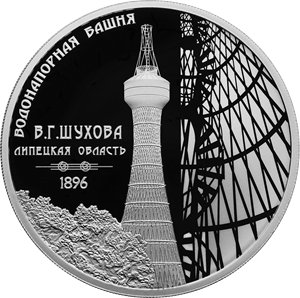Water Tower (Shukhov Tower in Polibino), Lipetsk Region
Obverse
a relief image of the National Coat of Arms of the Russian Federation and a semicircular inscription above it along the rim: ‘РОССИЙСКАЯ ФЕДЕРАЦИЯ’ (RUSSIAN FEDERATION) framed with paired diamonds on both sides, under the coat of arms there are the chemical symbol of the metal and fineness on the left and fine metal content and the mint trade mark on the right, at the bottom in the centre, in three lines, there is an inscription: ‘БАНК РОССИИ’ (BANK OF RUSSIA), the coin denomination: ‘3 РУБЛЯ’ (3 RUBLES), and the year of issue: ‘2023 г.’ (2023).
Reverse
an image of the water tower rising above tree crowns, designed in relief and laser treated for matte finishing; an image of the construction elements of the tower, laser treated for matte finishing, on the right; and the relief inscriptions on the left: ‘ВОДОНАПОРНАЯ БАШНЯ’ (WATER TOWER) around the upper circumference, and ‘В.Г. ШУХОВА’ (V. G. SHUKHOV) and ‘ЛИПЕЦКАЯ ОБЛАСТЬ’ (LIPETSK REGION) below in two lines, as well as the year ‘1896’ separated from the inscriptions by a decorative element.
Authors
Designers: E.V. Kramskaya (obverse), S.V. Sutyagin (reverse).
Sculptors: A.A. Dolgopolova (obverse), computer simulation (reverse).
Mint: Saint Petersburg Mint (СПМД).
Edge: 300 corrugations.
Discover more
Contemporaries called the engineer Vladimir Shukhov ‘a polymath’ and ‘a Russian Leonardo da Vinci’. He contributed to the development of the oil industry and construction, thermal engineering and shipbuilding, military industry and restoration. His drawings were used to build pipelines, river tankers, towers, and plants.
Vladimir Shukhov’s most renowned structure was a tower in the form of hyperboloid of revolution.
The main properties of hyperboloid structures are stiffness, wind resistance and the ability to carry weight exceeding their own. The structure invented by Shukhov was elegant and strong. Moreover, it was simple and cheap to assemble. To erect this tower, one only needed metal rings for the base, straight beams and fasteners.
Shukhov’s first hyperboloid tower was a 32-meter water tower presented in 1896 at the All-Russia Industrial and Art Exhibition in Nizhny Novgorod. The capacity of the tower’s tank was 10,000 buckets of water. There was a viewing platform on the top of the tower accessible by a spiral staircase.
After the exhibition in Nizhny Novgorod, Vladimir Shukhov was swamped with orders. The engineer designed and constructed hundreds of water towers, several railway bridges with spans, and compiled a new water supply project for Moscow.
Shukhov’s hyperboloid inspired the construction of the famous television broadcasting Shabolovka Tower, Stanislav-Adzhyhol Lighthouse, and six hyperboloid pylons for the power lines on the Oka River. Today, engineers all over the world continue to use the hyperboloid structures to design facilities for absolutely different purposes: from the Mae West sculpture in Munich to the Canton Tower, a TV tower in Guangzhou.
Source: https://www.culture.ru


